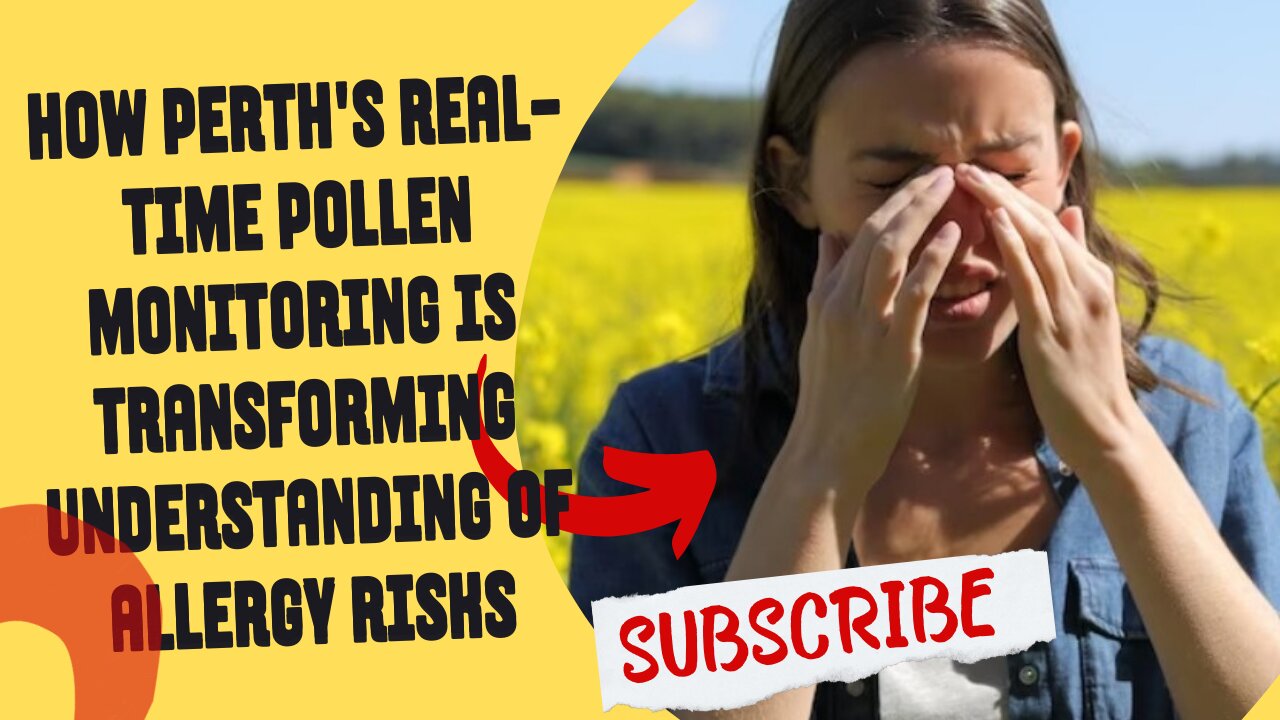Premium Only Content

How Perth's real-time pollen monitoring is transforming understanding
How Perth's real-time pollen monitoring is transforming understanding of allergy risks
Until 12 months ago, Perth only had access to daily pollen count data, created by researchers looking at a daily sample under a microscope.
But in November 2022, researchers at Curtin University installed an automated monitor to collect air samples and take holographic images of pollen "in-flight".
"This revolutionary instrument measures by hour, and so we can actually see how it fluctuates within the day," Ivan Hanigan, senior lecturer in climate change and health, told Gianni Di Giovanni on ABC Radio Perth.
The system uses two cameras that take shots of particles from two angles as they pass through a pipe in the monitor.
"We use an artificial intelligence algorithm that takes those two images and puts them together and draw a hologram, which is then analysed by the computer to tell us exactly what species these pollen grains are as they go past," Dr Hanigan said.
The only other such automated monitoring machine is installed in Melbourne.
New real-time information
Dr Hanigan said the device had yielded valuable information about the prevalence and patterns of pollen levels throughout the year and across the day.
"Something that we've managed to find out is different in Perth, it's peaking earlier, in October, whereas in Melbourne, it's peaking in November.
"During the day, we've also seen a difference. It's peaking in the evening in Perth, whereas it peaks in the middle of the day in Melbourne.
"It has implications for how you treat yourself."
This year however, the pollen count has been quite low, thanks to lower-than-average rainfall, leading to less grass, and more bare earth in the Perth environment.
"The grass pollen has been really low. We have tree pollen as well, but most people are allergic to the grasses, and it's been going down over the last few weeks," he said.
"I think we've had our peak.
"But the flipside of not having grass is that you've got bare earth, and exposed soil, and you get a lot of windblown dust."
There has been so much dust that the machine has had to be cleaned three times as often as the one installed in Melbourne, and the dust levels also have implications for respiratory health.
Clues to medication use
Dr Hanigan said more research was needed but it could give people a better understanding of when it was most valuable to use hayfever medication.
"We know that when you take your hayfever medication has a big impact on how you protect yourself, and it's probably best to start taking medication before you expect high pollen days.
"That's why we've worked on a forecasting system as well, where we use weather data and the grass maps, along with this near real-time data we're collecting to build a predictive model that says what [levels] will be in a few days' time."
Since Melbourne's severe thunderstorm asthma event in 2016, when two people died and 2,000 people called triple-0 for ambulances, due to a sudden change in the size of pollen particles, researchers around Australia focused attention on better understanding and predicting pollen levels.
WA is second only to Victoria in the amount of money spent on over-the-counter hayfever medication, and Dr Hanigan said the impacts at a population level were significant.
The AIHW [Australian Institute of Health and Welfare] have done an estimate that something like 18 per cent of Australians suffer from the kinds of chronic respiratory conditions that hayfever exacerbates," he said.
"It's not just the allergies, it's asthma, but also things like chronic respiratory diseases that are exacerbated, and it spreads across other aspects of our lives.
"It impacts mood, it's probably influencing mental health problems. It means there's lost productivity, as people can't work as effectively.
"Potentially [the] lost productivity is up to $5 billion a year."
-
 17:37
17:37
MetatronHistory
23 hours agoThe REAL Origins of the GREEKS
22.3K12 -
 1:19:32
1:19:32
The Daily Signal
9 hours ago $8.56 earned🚨BREAKING: James Comey & Letitia James NOT "Off the Hook" on Indictments, Sen. Kelly Court Martial?
32.2K4 -
 4:46:23
4:46:23
Drew Hernandez
1 day agoBONDI DOJ BLOWS IT ON COMEY/LETICIA INDICTMENTS?!
36.3K21 -
 2:34:03
2:34:03
PandaSub2000
4 days agoLIVE 10:30pm ET | CARMEN SANDIEGO
27.1K1 -
 12:10
12:10
Robbi On The Record
1 day ago $5.10 earnedKarmic Disclosure and Predictive Programming
32K4 -
 4:57
4:57
Gamazda
6 hours ago $5.83 earnedAerosmith - Dream On (Piano by Gamazda)
21.1K13 -
 8:12
8:12
Freedom Frontline
9 hours agoChip Roy DESTROYS Democrat After She Explodes Over Shutdown Truth
14.1K4 -
 2:29:50
2:29:50
We Like Shooting
18 hours ago $3.05 earnedWe Like Shooting 638 (Gun Podcast)
12.6K -
 46:09
46:09
MattMorseTV
6 hours ago $24.68 earned🔴Bondi just DROPPED the BALL... BIG TIME.🔴
25.7K135 -
 23:57
23:57
Jasmin Laine
10 hours agoCarney SNAPS at Reporters—MOCKS Trump and it BACKFIRES IMMEDIATELY
17K44